Stash, glorious stash! If you dabble in needlework as a hobby or even as a “serious” pursuit, chances are, you’ve built a stash. That’s a great part of the fun of needlework – setting in your supplies! It’s also a part of the creative process – exploring new items, seeing how you can integrate them into your techniques, or just plain playing around with “stuff” because it looks fun! I love stash! But it has its downsides…
An obvious downside of stashing a lot of stuff is organization. Organization of supplies is a huge topic, and since most people have their own approach, it’s kind of hard to go into it thoroughly. Suffice it to say, if you’re going to invest in “stash,” you should develop a system to keep it organized, so that you know what you have and can access it when you want it.
Another downside is that you can end up spending a lot of money, often unnecessarily, simply because something catches your eye. Oh golly. I’ve done that a lot. You can regulate this by setting up a “budget” for your hobbies. In your regular budget, make a little concession for your hobbies, and add to it a little at a time as you can. Then, when you have the opportunity for one of those “fun days out,” when you go visit a favorite store (or even a website!), or you go explore a new store, you know how much you can spend and you are cautious about what you buy. Set your limits and don’t go beyond them. Think of things you know you want or that you’ll really use, and try not to get distracted by Peripheral Stuff. Avoid impulse buying, just for the sake of buying! You’ll feel better later about your superior sense of self-control, and you’ll avoid “buyer’s remorse”!
All that having been said, I thought I’d share some photos of goods I added to my stash this past summer when I had the opportunity to visit a few needlework shops I had never been to. I’ll also share with you a couple of observations and one big mistake!
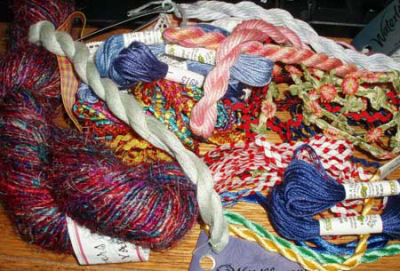
Here’s the general colorful pile. You can note the things in the pile that are typical of me, if you’ve read my website: silk floss (soie d’alger) in a couple colors I like and will use and some Caron Collections waterlilies (silk) and watercolors (cotton). There’s also, in the far background, barely visible, some little white cotton lace trim, perfect for linens. Ribbons, ric-rac, and a big blob of Sari Silk yarn…. some of these were definitely impulse items, and one was just plain a big mistake!
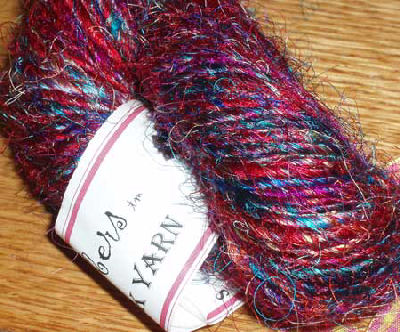
The Sari Silk yarn was actually not a mistake – when I came across it at one shop, I was delighted, because I’ve wanted to play around with it for a while, but the one time I had tried to place an order for it, the place was out of it. So here it was in person, I could touch it, examine it up close, and consider seriously whether or not the $14.00 was worth it. I thought, in the long-run, it would be – if not for me, for one of my nieces who crochets or one who knits, or even for my mom. Is it suitable for embroidery? Well, I want to see how it couches, just out of curiosity. So I will do that someday!
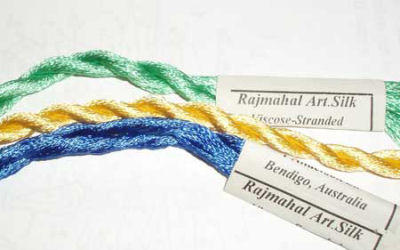
These are Rajmahal Art Silks. I’ve never actually worked with this thread, but I’ve always wanted to. It’s from Australia, in fact, and it isn’t silk! When I came across it that fateful day, I was already familiar with what it is, and in fact, I had one skein on hand, and I figured this was a good opportunity to expand to a few, so that I could give them a good test.
This particular shop experience was one of “those” experiences. You can always tell what store clerks know or don’t know about embroidery by certain things they say. In this particularly fine store, which focuses more on “unique” supplies, antique ribbons, and various antique needlework items – a beautiful and rather ritzy store – the clerk greeted us at the door with the “warm” enthusiasm of someone who would not mind taking the time showing us around, if she had to! She was dressed sleekly, in a skilled imitation of “haute couture” fashion. I was duly impressed and let her show me around, although I pretty much knew where my interests lay once I walked in. I asked if she were the owner – no, no. But she and the owner, she told me, are both artists – textile artists, actually. She pointed out several of the focal points of the shop, including antique buttons and beads, antique ribbons, “modern” ribbons, some fun trims, and whatnot. I wanted to take a closer look at the real antiques they had on display – a beautiful shawl all worked over in goldwork, and a fantastic Victorian crazy quilt behind glass, covered in gorgeous stitchery – and many other items of delectable interest! I asked if I could take pictures of the shop, and it was the first retail place where I’d ever been told “no.” (Next time, I’ll contact them in advance and speak to the owner instead of the clerk!)
Then, as she warmed up a bit and realized that I wasn’t there to pilfer the shop or to ask “stupid questions,” she asked me if I was a textile artist. Textile artist is a strange phrase – I wouldn’t use it to describe me at all, because it’s far to professional and polished, (especially when you’re in a store like that!), and none of my degrees are in the study of textiles by a long stretch!
“No, I just dabble in embroidery,” said I. “I’m particularly interested in goldwork.”
“Oh,” was her rather non-committal reply.
“That’s why I wanted to take a photo of that shawl.”
“What shawl?”
“The goldwork shawl?”
“I’m not exactly sure what you mean by goldwork.”
So I explained. “I’ve never really heard of goldwork. I’m sure Gretchen has.” (Apparently, the shop owner…)
Then I mentioned I like working with silk. “OOOHHH – we have some marvelous silk thread here.” And she showed me …. the Rajmahal. “It’s so nice. We use it for all our needlework. We love silk. And Gretchen swears by this brand because of the sheen.” [I was chuckling internally by this time]… “Natural silk,” she continued to explain, “has the highest sheen.”
I was in awe of her knowledge. I showed my approval by selecting the three colors above, and by agreeing with her that the thread had an extraordinary sheen. Considering there were a few other folks in the shop, I didn’t want to… you know, put her on the spot!
Then I went on to look at the various ribbons, and this is where I made My Big Mistake! And this is what I get for feeling so SMUG about the “natural” silk!
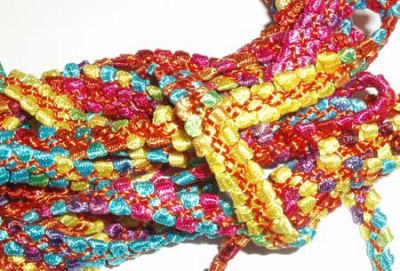
I explored the various typical but darling tiny ric-racs and trims, and bought a few of those, and I picked up a couple yards of the above trim, only because it was different and rather neat. I could see it used to trim out a little something at some point.
And then I saw this stuff:
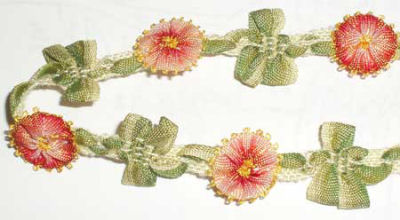
Isn’t it pretty? It really is pretty! I could see it trimming out a collar on a little girl’s dress or blouse. And I fell in love with it. I’m not super “up” on ribbon, types of ribbon, and whatnot. I saw it, saw that it was beautiful, and wanted some. I glanced (key word – glanced) at the casing, on which I saw marked $1.10. I had just bought some $.80/yard ric-rac, some $1.00 / yard other stuff, and even, yes, some $2.50 / yard other stuff. So I saw that, and I thought, “Wow, it’s so pretty – and so inexpensive!”
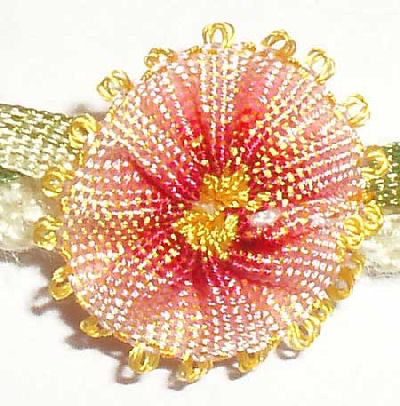
The whole ribbon is actually a composite of little ribbon pieces, put together very attractively so that they look like flowers and bows.
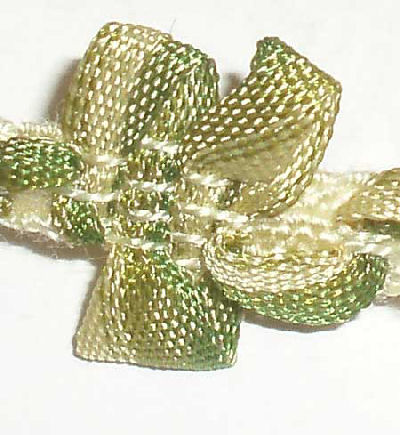
You can buy all the separate types of ribbon, actually, and make up your own composite ribbon, if you’re game for it!
This specialty ribbon, I’ve since learned, is Mokuba ribbon. Mokuba is a company name synonymous with high quality trims in the fashion world. I might know my silk, but I don’t know my ribbon!
I decided on a yard, of course – why not? And it also came in violet – so a yard of that, too. While the clerk cut the first yard (working behind the sign that clearly read, “All cuts final”), I continued to explore. She asked how much of the violet flowered trim I wanted. “Oh, a yard is fine.” She hesitated. I wondered. She measured it out. And then she said (God bless her!) “Are you sure?” I suddenly figured it out. “How much is it?” I asked. “It’s $1.10 an inch.”
Oh well. I swallowed my pride. I declined the violet, but in all fairness, paid for the coral flowered trim, because, after all, all cuts were final. She was just doing her job – and she did save me from a SECOND $40 mistake. She explained that most “clients” didn’t purchase even a yard at a time. Well, heck — if you’re not buying a yard of ribbon, what could you possibly be using it for??? I know, I know – little things.
As I checked out, trying not to visibly wince, I did manage to mention that Rajmahal is actually viscose – as it says on the tag – and not silk. But I did concede that it does indeed have an exceptional sheen!







Uh… $1.10 an inch o_O
I actually have a ribbon similar to that, or two, I think, and they costed no more than 2 euro the meter in Barcelona. No flowers though. I could take a picture if you want to see. Galloons and trims are my weak spot.
I’d love to see them, if you want to take a photo! I’ll admit, trim is becoming more of a weak point with me, too!
Mary, Rajamahal is actually 35% silk floss. I work with it and like it a lot.gawjqz
Here it is:
http://www.innershelter.net/journal/2007/09/trim.jpg
I have another one in orange and green, made with some sort of orgaza ribbon, but I cannot find it!
That is GORGEOUS, Mer… I love the colors! They had organza ribbon that was embroidered with flowers and other silk ribbon (on top of the organza) at this shop, too. Gorgeous stuff, but I think they may have been over-priced, now that I look around a bit at that type of ribbon!
Thanks for sending the link to the photos – for those of you who want to see some more trim, Mer’s is in deep reds and greens and is really lovely stuff. Perfect for winter, too! I was recently planning out a Christmas ornament for a gift – this would make great trim for an ornament! This is the direct link. Otherwise, you can cut and paste the url above into your browser.
Thanks again, Mer!